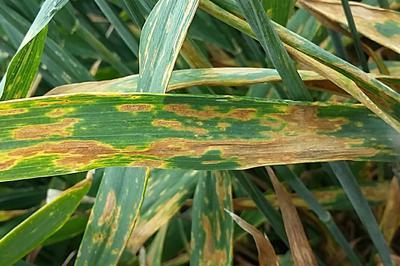Snow Mold of Cereals
Monographella nivalis
Nấm
Tóm lại
- Brown lesions and decay on leaves and internodes.
- Rotton (sometimes orange) stems.
- Ears can bleach or exhibit orange to purplish brown fungal tissue.
Cũng có thể được tìm thấy ở
Triệu chứng
Infected seedlings may show brown lesions on early leaves or die right after germination (dieback). Older plants feature brown decay of the lower leaves (sometimes with dark fruiting bodies in leave sheaths) and grayish-brown blotching of lower internodes that later moves up to the higher ones. Severely infected stems are rotten and can show orange fungal growth. Under adverse weather conditions they may break at ground level. Small, brown, water-soaked lesions can appear on florets, that can take on a bleached color in stages when they should still be green. Under warm and humid conditions, spikelet bases may exhibit orange fungal tissue and bracts can become purplish-brown.
Các khuyến nghị

Kiểm soát hữu cơ
Widespread cold-resistant bacteria residing in the soil can effectively impair the life cycle of the fungus and reduce the severity of infections.

Kiểm soát hóa học
Always consider an integrated approach with preventive measures together with biological treatments if available. Chemicals that can be used for seed treatments include azoles (e.g. triadimenol, bitertanol, prothioconazole) or strobilurins (e.g. fluoxastobin) and fuberidazole or iprodione.
Nguyên nhân gây bệnh
The symptoms are caused by the soil-borne fungus M. nivale. It survives during summer in plant debris or soil. In fall or winter when cool, wet weather arrives, the fungus grows and produces spores that infect seedlings and lower leaves. These spores are spread by wind and surface water. They contaminate other plant parts and other crops in the field, causing severe infections. The fungus has an optimal growth at temperatures between 18 and 20 °C but in some cases, they can also grow at temperatures as low as -6 °C and as high as 32 °C. Infections of the lower plant parts occurs under cold, dry conditions, whereas ear infection is promoted by wet, warm periods.
Biện pháp Phòng ngừa
- Plant resistant varieties, if available.
- Avoid excessive fertilization with nitrogen or lime.
- Try to minimize surface moisture by e.g.
- drainage or soil pricking.
- Carefully remove plant debris after harvesting.
- Plow the ground to remove remaining spores.
- Fertilizing with potassium-rich compounds in autumn contains M.
- nivalis spreading.



